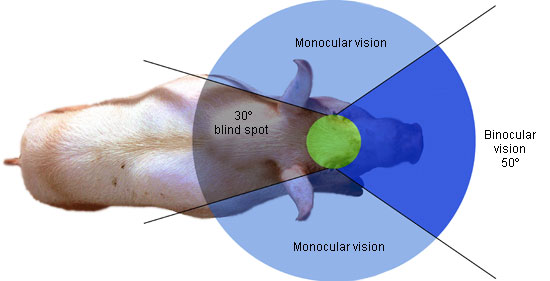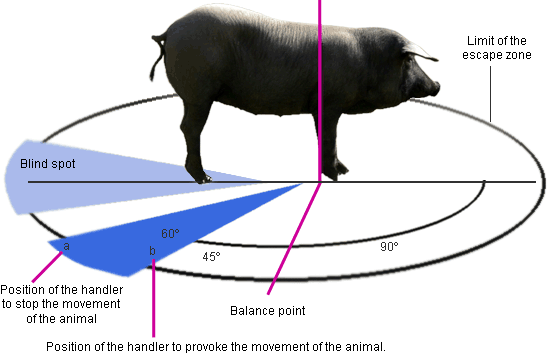Pigs have a panoramic vision of 310º and binocular vision of 35-50º (Fig. 1). This means that compared to humans, pigs prioritise their lateral monocular vision and this increases their panoramic vision (greater capacity for detecting possible danger, food, other pigs, etc) and decreases their bifocal vision (greater difficulty for calculating distances). Therefore, when it is necessary to manage the pig in a holding pen, this lateral vision of the world should be taken into account since an opening at the side of the chute may not seem important to us (as we have frontal vision), but the pig is going to find it at the centre of its visual field. This can sometimes lead to the pig trying to escape through small gaps which we had not thought to be a problem. It is therefore adviseable to make sure that the chutes are completely closed at the sides to stop the animals from being distracted or startled by any other stimulus aside from the actual handling.

The presence of rods and cones that are sensitive to two types of wavelength within the blue and green frequencies leads us to believe that pigs have a certain capacity for the perception of colour, although we still do not know to what point this perception arrives. Whatever the case, the pig sense of vision has little to do with human vision, since for pigs the senses of smell and hearing are more important. This means that the animal uses its hearing and smell to situate itself in its surroundings using sight as a complement to the information gathered by these two senses, while humans use hearing and smell to complete the information obtained by our sense of vision. So, just as we will visually search for the source of the problem when we smell gas on entering a room, a pig will tend to stop to sniff the floor when we change any part of its living space. This means that if we wish to transfer an animal in the quickest possible way, we should make sure that there are no changes to the floor surface of the chute or any strange objects in the way, and we should also avoid having areas of light and shade, which due to the pig’s vision may be confused with changes of the floor surface. While keeping all of this in mind, we should also consider that the animal will continue to have the need to sniff around wherever it goes, so the tendency will be for it to come to a halt. For this reason, in order to make a good transfer it is also important that pigs be kept in small groups, of 5-7 animals. This allows us to maintain a certain level of control of the animals and means that the pigs do not come to a halt so often. With larger groups we can often lose control of some of the animals, blocking may occur and the handler has to increase the level of threat on the nearest animals in order that they become excited enough to provoke not only their own movement but also that of the other pigs that have come to a halt a few metres in front of them. It is important to keep in mind that the personnel that handle the animals is always playing the role as a threat factor for the animals, this is what gets them to keep moving. It is important to get the animals moving in the right manner, which is not overexcitable, and for this reason it is vital to control our capacity as threat factor. If we make the animals run then it is clear we are not doing our job correctly. If the pigs are submitted to a threat that is too strong or constant then we will have hyperactive animals, or frightened animals that react negatively to everything, even to those stimuli that cause other pigs simply to explore (Fig. 2).

Figure2a. An animal is shown with a low level of anxiety, in such a way that when it prepares to eat the apples in the trough just as it has done on previous days and it finds a new object (the ball), it investigates with interest while appearing to remain in a calm state.
Figure2b. An animal is shown with a higher level of anxiety, and here the animal perceives the same stimulus (the ball) as a threatening factor. This increases the animal's general activity and its desire to escape in any way from the pen (count the number of white lines that the animal crosses).
Fear will always condition the animal's escape zone or personal zone. If we do not enter into this personal zone the animal will not see itself in any danger and will therefore not move to get away. A fearful animal will see itself in danger well before any other animal, so it will move away from us much sooner. The direction in which the animal moves is not improvised either. Evolutionarily the pig has learnt that if the danger comes from in front then it is better to move back, and if the danger comes from behind then it is better to move forward. This determines what is known as the balance point of the pig, which will determine the direction of the pig's escape in relation to our position (Fig. 3). So, in order to control the pig's movements correctly, we must approach the animal slowly so as not to provoke an exaggerated response when entering the escape zone and we should keep in mind the animal's balance point in order to get the animal moving in the desired direction.

Figure 3. Balance point of the pig. If the intention is to move the pig in a forward direction, the animal handler should be situated at point b.



